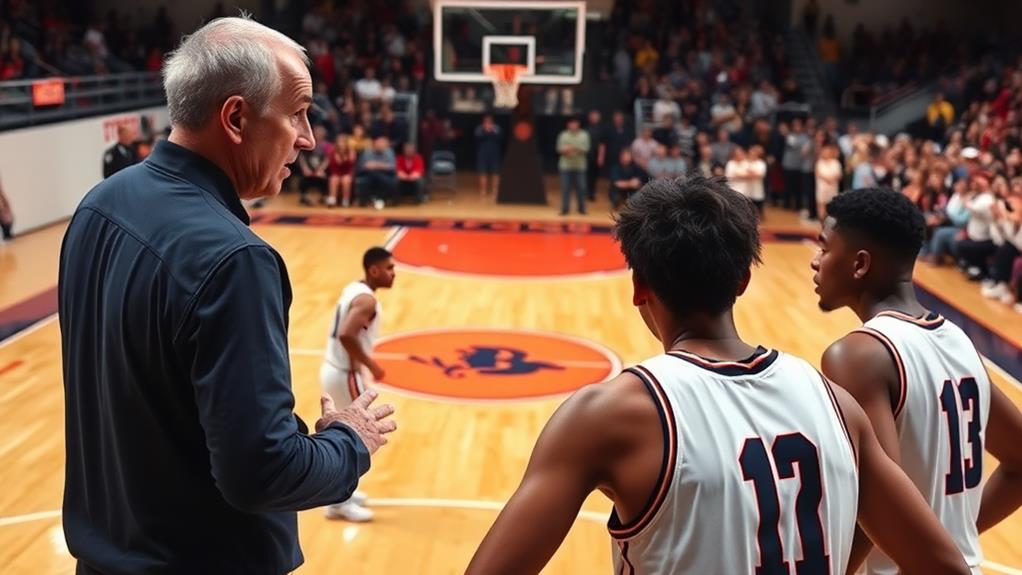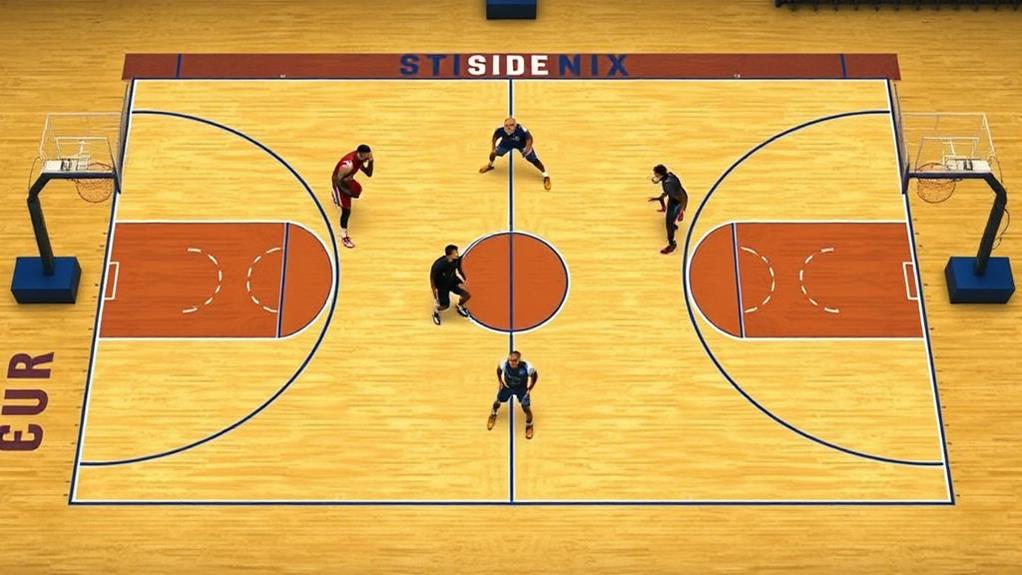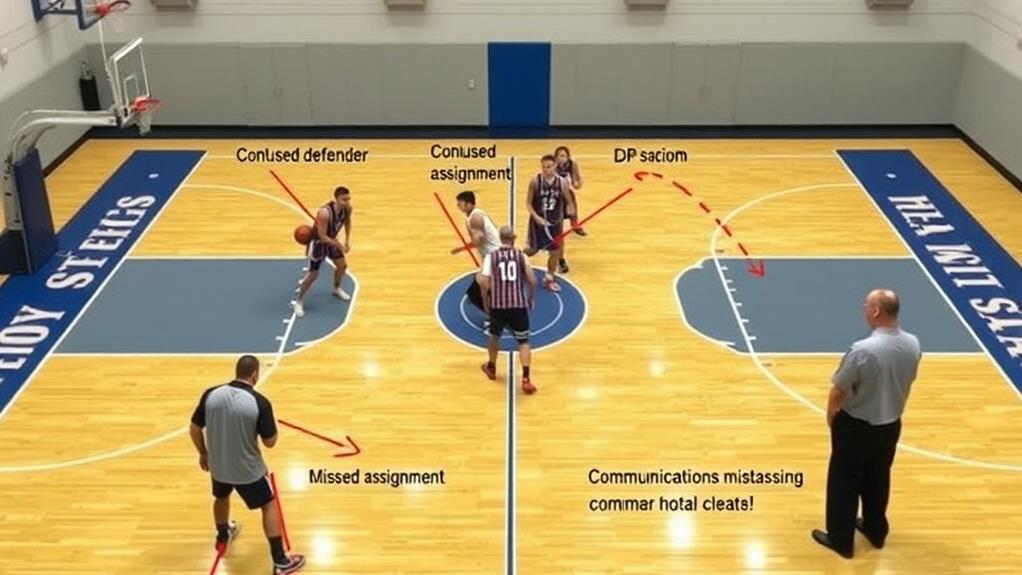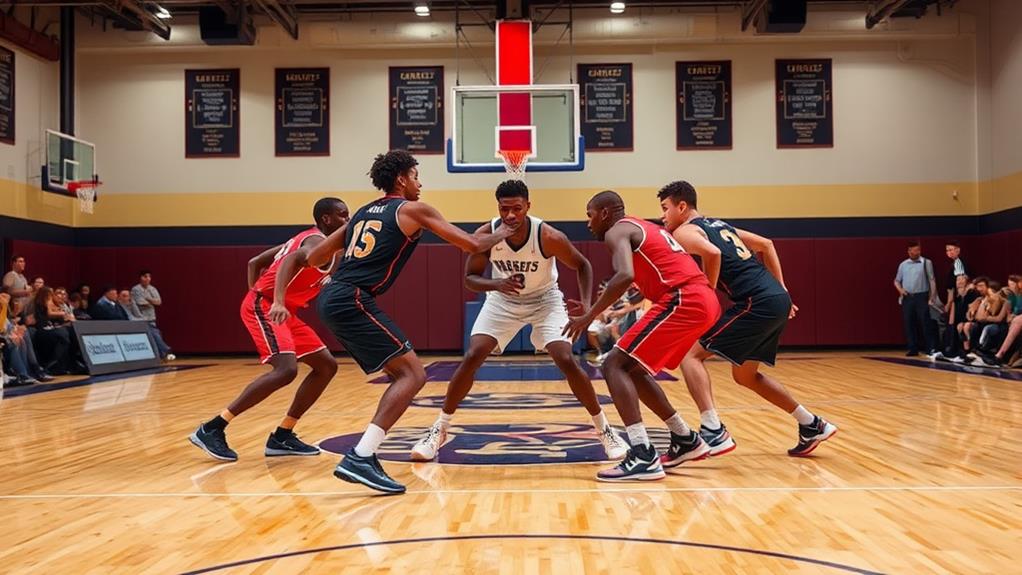
Mastering the Box-and-One Defense in Basketball
September 14, 2024Mastering the Box-and-One defense can greatly boost your team's ability to neutralize dominant scorers. This hybrid strategy combines a zone defense with a man-to-man approach, placing four players in a box formation while one closely guards the top scorer. To execute it effectively, assign clear roles and emphasize communication among defenders. Always adapt your positioning based on offensive movements, maintaining spatial awareness to avoid breakdowns. Practicing specific drills will enhance your team's agility and teamwork. By exploring further, you can discover advanced techniques and insights to refine your Box-and-One strategy even more.
Understanding Box and One Defense
Mastering the Box and One defense can dramatically enhance your team's ability to neutralize a dominant scorer. This hybrid strategy employs four players forming a box zone while one defender, known as the chaser, closely guards the opposing team's top scorer. By doing this, you disrupt the offensive flow, forcing other players to step up and take on more responsibility.
Additionally, understanding the rules of the game can provide a strategic advantage when implementing this defensive setup, allowing your team to exploit scoring opportunities while minimizing penalties.
In the Box and One defense, communication is essential. As zone defenders cover their assigned areas, they must remain alert to the movements of the chaser and the ball. Quick adjustments are imperative, especially when the offense tries to exploit gaps or rotate the ball rapidly.
The defense's effectiveness can wane against teams with multiple scoring threats, so adaptability is important.
To boost your team's proficiency in this setup, practice specific drills that emphasize mirroring the chaser's movements while maintaining spatial awareness among the zone defenders. This guarantees that everyone knows their roles and responsibilities, allowing your team to execute the Box and One defense effectively.
With practice and understanding, you can turn this strategy into a powerful tool against your opponents.
Implementation and Setup
To effectively implement the Box-and-One defense, start by organizing your players into their designated roles. Assign one defender as the chaser, responsible for closely guarding the opposing team's primary scorer. This player should possess agility and a knack for anticipation to limit the star player's impact.
The other four defenders will form a box, positioned at the low blocks and elbows, aimed at protecting the basket and contesting outside shots. Incorporating cardio workouts can also enhance your players' endurance, guaranteeing they maintain high energy levels throughout the game.
Next, make sure that your defenders communicate effectively. They need to quickly adjust their positioning based on offensive movements, maintaining awareness of their assigned zones. It's essential for them to stay vocal, calling out screens or cuts from the offense to remain coordinated.
To enhance their skills, practice specific drills that simulate game scenarios. This helps your defenders adapt to dynamic movements, allowing them to execute their roles effectively in the Box-and-One setup.
Emphasize the importance of teamwork during these drills, as the success of the Box-and-One defense relies heavily on the defenders working together. With proper implementation and setup, you'll create a robust defense that can stifle even the most potent offensive threats.
Roles and Responsibilities

In the Box-and-One defense, each player has specific roles that are essential for success. The chaser's key tasks involve closely monitoring the opponent's best scorer, while the zone defenders are responsible for covering areas and providing support against penetration.
This type of defense requires a high level of adaptability, as it must counteract the evolving offensive strategies seen in modern basketball, including the increased reliance on defensive schemes informed by analytics.
You'll need to understand the chaser's key tasks, the responsibilities of the zone defenders, and the importance of communication and adjustments among the team. By mastering these aspects, you can effectively disrupt the opposing team's offense and enhance your overall defensive strategy.
Zone Defender Responsibilities
Zone defenders in the Box-and-One defense play an important role in controlling the game by covering specific areas on the court. Your primary responsibility as a zone defender is to guard your designated zone, with top defenders positioned at the elbows and bottom defenders near the low blocks.
The top zone defenders must stay alert, ready to help defense on drives or contest perimeter shots. You need to guarantee no open shooting opportunities arise while maintaining awareness of your assigned area.
As a bottom zone defender, your focus is on protecting the paint and providing help during dribble penetration. You'll need to cover the corners effectively, limiting the opponent's chances to score from outside.
Communication among zone defenders is critical for this defensive strategy, allowing you to adjust quickly to offensive movements and close any gaps.
Additionally, it's important to anticipate the star player's movements, adapting your positioning to contain scoring threats while fulfilling your zone responsibilities.
Chaser's Key Tasks
The chaser's main role in the Box-and-One defense is to stick closely to the opposing team's primary scorer, applying constant pressure to disrupt their rhythm.
To excel in this role, you need to focus on several key tasks:
- Follow the scorer: Keep a tight leash on the player, anticipating their movements to limit scoring opportunities.
- Maintain agility: Stay quick on your feet, ready to react to cuts and changes in direction.
- Communicate effectively: Alert your teammates about potential screens or offensive shifts that could open up passing lanes.
- Balance pressure and support: Avoid overcommitting; guarantee you're in a position to help defend against any passes or drives.
Communication and Adjustments
Effective communication is essential for executing the Box-and-One defense successfully. As a defender, you need to relay information about the ball's location and movements of both the primary scorer and your assigned zones. Each zone defender, like X1 and X3, must cover the high post and wings, while X4 and X5 protect the low blocks and corners. You must stay aware of your designated area.
The chaser plays an important role in this communication, constantly alerting zone defenders of potential screens or cuts from the star player. This guarantees timely help defense when needed.
Adjustments are critical, too. If the primary scorer tries to exploit mismatches or is doubled, you may need to switch roles or positions quickly.
To enhance communication and support seamless defensive rotations, practice drills focusing on mirroring and situational awareness are key. These drills will help you anticipate offensive strategies in real-time, allowing your team to adapt effectively.
Advantages of Box and One
Box and One defense offers several key advantages that can shift the momentum of a game in your favor. This strategy effectively neutralizes the opponent's primary scorer while maintaining a solid zone structure with four defenders. By applying individual pressure, you disrupt their offensive flow, compelling others to step up and potentially make mistakes.
The evolution of defensive strategies, including the Box and One, reflects the ongoing adjustments teams make to counter offensive innovations like the three-point shot dominance.
- Disrupts offensive rhythm: Your chaser can throw off the primary scorer's game, leading to rushed shots or turnovers.
- Exploits weaknesses: If the opposing team struggles with perimeter shooting, your zone defenders can focus on protecting the paint while contesting outside shots.
- Creates confusion: The blend of man-to-man and zone principles can confuse opponents, leading to miscommunication and poor shot selection.
- Facilitates quick changes: The Box and One setup allows you to easily adapt to different offensive strategies, keeping your team one step ahead.
Common Mistakes and Solutions

When running the Box-and-One defense, it's easy to overcommit to the primary scorer, leaving other players open for easy shots.
Effective communication among defenders is vital, as it mirrors the importance of teamwork in soccer, where effective communication and formations are essential for role clarity and overall team performance.
You also need to guarantee your defenders communicate effectively; a lack of calls can lead to costly breakdowns.
Recognizing these mistakes and addressing them will strengthen your team's defensive strategy.
Overcommitting to Primary Scorer
Overcommitting to the primary scorer in the Box-and-One defense can easily lead to defensive breakdowns, leaving secondary players wide open for scoring opportunities.
When defenders lose sight of their responsibilities, it creates gaps in coverage that opponents can exploit. To prevent this from happening, focus on the following strategies:
- Maintain spatial awareness to guarantee defenders can rotate effectively.
- Emphasize communication among the defenders to stay alert to threats.
- Incorporate practice drills that balance pressure on the primary scorer with coverage on others.
- Review game footage to identify instances of overcommitting and adjust strategies.
Ineffective Communication Among Defenders
Defensive breakdowns often stem from ineffective communication among defenders, particularly in the Box-and-One setup. When defenders fail to communicate clearly, it allows the primary scorer to exploit mismatches or find open shots, breaking down your coverage.
To prevent this, establish clear verbal cues and signals during practices. Use specific phrases or keywords to call out screens, cuts, and switches, ensuring everyone knows their assignments.
Inadequate communication can lead to confusion, especially if the chaser fixates solely on the primary scorer. Regular drills that emphasize defensive communication can enhance teamwork and spatial awareness, allowing you to anticipate your opponents' movements better.
Encourage your teammates to vocalize their actions consistently, which can prevent breakdowns in coverage.
Additionally, reviewing game footage where communication faltered can pinpoint specific moments that need improvement. Focus on enhancing both verbal and non-verbal communication strategies among defenders.
Offensive Strategies Against Box and One
Facing a Box-and-One defense can be challenging, but with the right offensive strategies, you can effectively counter it. By leveraging advanced analytics to assess the defensive alignment, teams can identify weak spots and optimize their movement.
Focus on quick ball movement to exploit defensive gaps and create open shot opportunities. Here are some key strategies to implement:
- Utilize skip passes to stretch the defense, moving the ball quickly across the court and finding mismatches against the zone defenders.
- Incorporate dribble drive penetration towards the elbows to open up scoring lanes. If the defense collapses, you'll have kick-out options to find open shooters.
- Involve your post players as decoys or distributors. This tactic can confuse zone defenders, leading to mismatches and high-percentage shots for perimeter players.
- Encourage quick decision-making among your players. Ascertain your sharpshooters are ready to capitalize on openings created by the Box and One defense.
Key Examples in Action

The effectiveness of the Box-and-One defense shines through in several key examples from high-stakes games. Take the Toronto Raptors, for instance, who effectively implemented this strategy against Jason Tatum in Game 4 of the 2022 NBA Playoffs. By focusing on Tatum, the Raptors greatly limited his scoring opportunities, allowing their team to regain control of the game.
This kind of tactical flexibility is essential in basketball, much like the adaptability in formations seen in soccer. In the 2019 NCAA Tournament, Texas Tech deployed the Box-and-One to stifle Michigan's star player. This forced other players to step up, creating a challenging environment for Michigan's offense and allowing Texas Tech to advance.
Similarly, during the 2006 NBA Finals, the Miami Heat utilized the Box-and-One defense to neutralize Dirk Nowitzki, which played an essential role in their championship victory.
High school teams also take advantage of this strategy, often turning to the Box-and-One to disrupt the rhythm of games dominated by standout players. Coaches frequently choose to employ the Box-and-One defense in critical moments, particularly when guarding the team's best player becomes vital for securing a win.
These examples highlight the Box-and-One's effectiveness in limiting scoring opportunities for top scorers across various levels of competition.
Training Drills for Mastery
Mastering the Box-and-One defense requires focused training drills that sharpen players' skills and enhance teamwork. To achieve this, you should incorporate a variety of drills, each targeting specific aspects of the defense. For instance, incorporating ball control drills can improve players' ability to maintain possession under pressure, essential for executing the Box-and-One effectively.
- Breakdown drills: Practice roles in the Box-and-One against designated offensive players, emphasizing proper positioning and communication.
- Mirror drills: Enhance the chaser's agility and anticipation by shadowing an offensive player, ensuring defensive discipline at all times.
- Situational drills: Simulate game scenarios, such as defending against the ball in the corner or high post, to prepare for vulnerabilities in real-game situations.
- Competitive drills: Track successful defensive actions like deflections or steals against offensive actions such as scoring, motivating players to focus on their roles and boost performance.
Additionally, regularly reviewing game footage of your Box-and-One implementations helps identify strengths and weaknesses in execution.
This targeted practice allows for meaningful adjustments that can enhance overall team performance. By incorporating these focused drills, you'll master the intricacies of the Box-and-One defense and improve your team's effectiveness on the court.
Conclusion
In mastering the box-and-one defense, you've embraced an effective and engaging strategy that can elevate your game. By understanding its setup and roles, you'll bolster your team's defensive prowess. Remember, practice makes perfect—so implement drills to develop discipline and dexterity. With these tactics, you'll thwart talented scorers while fostering teamwork. Stay sharp, stay strategic, and soon you'll see success soar as you solidify your skills in this standout defensive scheme.


